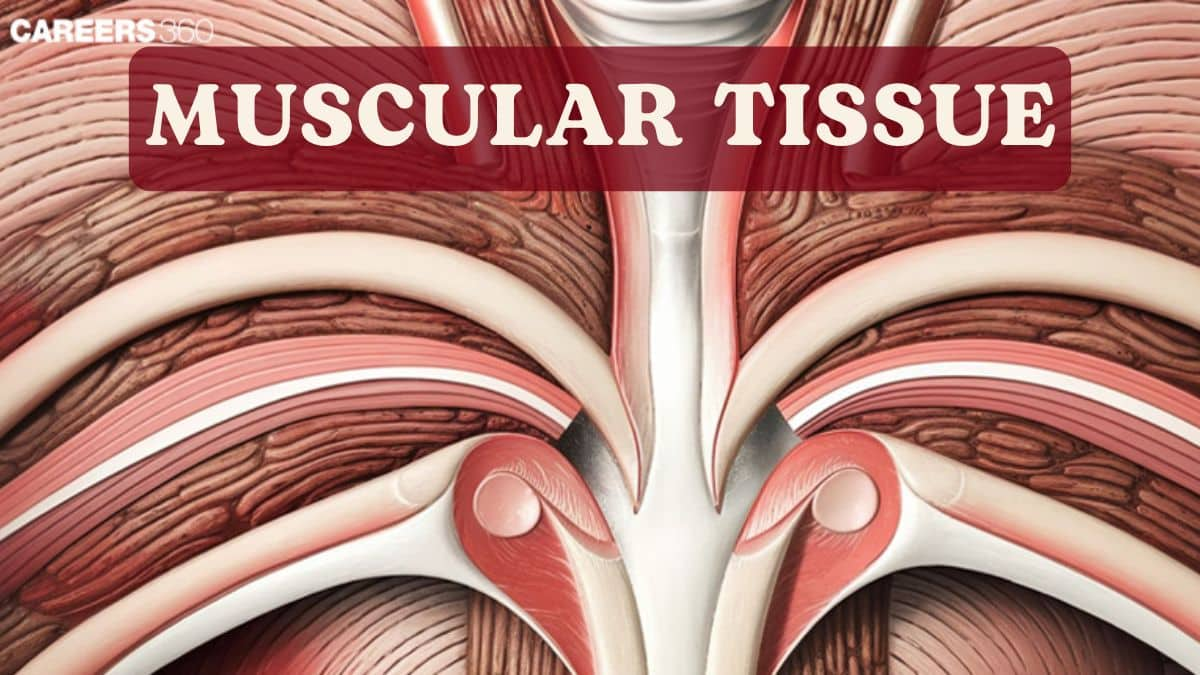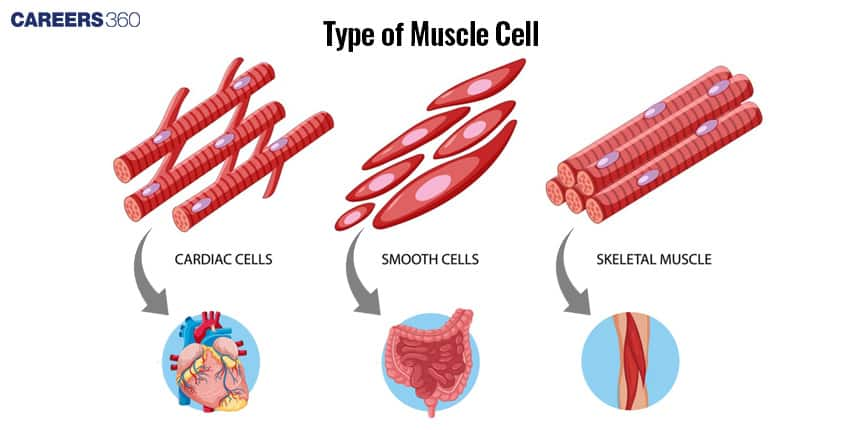Muscular tissues
Muscular tissue enables movement, posture, circulation, and vital physiological processes. It includes three main types: skeletal (voluntary), cardiac (heart-specific), and smooth (involuntary). Class 11 Biology and NEET focus on their structure, functions, and health importance.
This Story also Contains
- What is Muscular Tissue?
- Types of Muscular Tissues
- Structure of Skeletal Muscle
- Functions of the Skeletal Muscle
- Structure of Cardiac Muscle
- Functions of Cardiac Muscle
- Structure of Smooth Muscle
- Functions of Smooth Muscle
- Importance of Muscular Tissue to Health
- Muscular Tissue NEET MCQs (With Answers & Explanations)
- Recommended Video on Muscular tissues

What is Muscular Tissue?
Muscular tissue is a special, usually involuntary tissue bringing about movements of the body and its parts. The primary function of muscle is the transformation of chemical energy into mechanical energy to generate force, perform work, and produce movement. In addition, muscle tissues stabilize body position, regulate organ volume, generate heat, and propel fluids and food matter through various body systems.
Types of Muscular Tissues
There exist three types of muscular tissues that form the human body: skeletal, cardiac, and smooth muscles. Although the different types of muscular tissue share some properties, they differ from one another in their microscopic anatomy and location, and in how they are controlled by the nervous and endocrine systems.
Skeletal Muscle
Skeletal muscle tissue is so named because most skeletal muscles move the bones of the skeleton. Skeletal muscle tissue is striated, alternating light and dark protein bands are seen when examined with a microscope.
Skeletal muscle tissue works mainly in a voluntary manner. Its activity can be consciously controlled by neurons (nerve cells) that are part of the somatic (voluntary) division of the nervous system. Most skeletal muscles also are controlled subconsciously to some extent. For example, diaphragm continues to alternately contract and relax without conscious control so that breathing does not stop.
Cardiac Muscle
Only the heart contains cardiac muscle tissue, which forms most of the heart wall. Cardiac muscle is also striated, but its action is involuntary. The alternating contraction and relaxation of the heart is not consciously controlled. Rather, the heart beats because it has a natural pacemaker.
Smooth Muscle
Smooth muscle tissue is located in the walls of hollow internal structures, such as blood vessels, airways, and most organs in the abdominal cavity. It lacks the striations, i.e., nonstriated, which is why it is referred to as smooth. The action of smooth muscle is usually involuntary. Both cardiac muscle and smooth muscle are regulated by neurons that are part of the autonomic (involuntary) division of the nervous system.

Structure of Skeletal Muscle
Each of your skeletal muscles is a separate organ composed of hundreds to thousands of muscle fibers (myocytes). Skeletal muscle also contains connective tissues surrounding muscle fibers, and blood vessels and nerves.
Muscle Fibers
Being long and cylindrical, muscle fibres are multinucleate, striated, and present in skeletal muscles due to an arrangement of myofilaments.
Connective Tissue
A little connective tissue covers each fibre, contributing to the overall support and protection of the muscle. Connective tissue continues and forms tendons that attach the muscles to bones.
Neuromuscular Junction
The point at which a motor neuron reaches a skeletal muscle fibre is called the neuromuscular junction, where the impulse from the nerve stimulates a muscle contraction.
Functions of the Skeletal Muscle
Functions of the skeletal muscles are:
Voluntary Movement
Skeletal muscle enables voluntary actions or movements such as walking, running, and lifting.
Posture and Joint Stabilization
The skeletal muscles also help in maintaining posture and joint stabilization during movement.
Heat Production
Muscle contractions generate heat that is quite vital to the thermoregulation of the body.
Structure of Cardiac Muscle
Between the layers of cardiac muscle fibers are connective tissue that contain blood vessels, nerves, and the conduction system of the heart. Cardiac muscle fibers have the same arrangement of actin and myosin and the same bands as skeletal muscle fibers. However, intercalated discs are unique to cardiac muscle fibers.
Cardiac Muscle Fibers
The cardiac muscle fibre is shorter, and it is also branched with a single or two centrally placed nuclei.
Intercalated Discs
These are specialized structures that join the cardiac muscle cells and allow rapid communication that enables fast and synchronized contractions.
Striations
Cardiac muscle is striated similar to skeletal muscle because its myofilaments are oriented parallel to each other.
Functions of Cardiac Muscle
Functions of the cardiac muscles are:
Involuntary Contraction
Cardiac muscle undergoes involuntary contraction that allows the heart to pump blood throughout one's life without conscious control.
Rhythmic Contraction
The rhythmic contractions are initiated by the self-conducted electrical impulses from the heart's pacemaker cells to provide a constant heartbeat.
Structure of Smooth Muscle
Like cardiac muscle tissue, smooth muscle tissue is usually activated involuntarily.
Smooth Muscle Fibers
It is thickest in the middle and tapers at each end. Within each fiber is a single, oval, centrally located nucleus.
Lack of Striations
It also contains both thick filaments and thin filaments, but they are not arranged in orderly sarcomeres as in striated muscle. Because the various filaments have no regular pattern of overlap, smooth muscle fibers appear smooth.
Innervation
Smooth muscle is innervated by the autonomic nervous system, therefore it performs involuntary functions.
Functions of Smooth Muscle
Functions of smooth muscles are:
Involuntary Movement
Smooth muscles control involuntary movements, such as peristalsis in the digestive tract and the constriction of blood vessels.
Regulation of Body Organ
By regulating the diameter of many blood vessels and the flow of substances through hollow organs, smooth muscle does its job.
Importance of Muscular Tissue to Health
Muscular tissue serves several important functions in the human body. They also aid in many physiological processes like locomotion, digestion, and circulation.
Muscular tissues are essential to health maintenance and functionality.
They provide mobility, assist key physiological processes, and allow the body to respond to environmental fluctuations.
The consequence of disorders in these muscular tissues is severe health impairments related to mobility and cardiovascular problems.
Muscular Tissue NEET MCQs (With Answers & Explanations)
Important topics that are frequently asked in NEET exam are:
Types of Muscular Tissue (Skeletal, Cardia, Smooth muscle)
Unique features of each Muscular Tissue
Neuromuscular junction
Functions of muscular tissue
Practice Questions for NEET
Q1. _________ joins muscles to bones and is made up of thick fibrous (collagen)
Areolar tissue
Tendons
Ligaments
Adipose Tissue
Correct answer: 2) Tendons
Explanation:
Tendons connect muscles to bones and are composed of thick, fibrous collagen. These structures are strong and flexible, allowing for the effective transfer of force from muscles to bones, which facilitates movement. Tendons are designed to withstand tension and provide stability to joints during physical activity.
Hence, the correct answer is option 2) Tendons join muscles to bones and are made up of thick fibrous (collagen).
Q2. Muscle fibre is covered by
Epimysium
Perimysium
Endomysium
Mesomysium
Correct answer: 3) Endomysium
Explanation:
Many muscle fibrils are grouped and form muscle fascicles. Many muscle fascicles are grouped and form muscle. Muscle fibre is covered by endomysium. Muscle fascicles are covered by perimysium and muscle is covered by epimysium. These muscle fascicles are then grouped to form the entire muscle. Each muscle fibre is wrapped in a connective tissue layer called the endomysium, providing support and protection. The fascicles themselves are covered by a layer of connective tissue called the perimysium, and the entire muscle is encased by the epimysium, which helps maintain muscle integrity and transmit force during contraction.
Hence, the correct answer is option 2) Endomysium.
Q3. Identify the underlying cause of shivering during cold winter weather.
It is a result of voluntary action in striated muscles.
It is a result of voluntary action in smooth muscles.
It is an involuntary action in striated muscles.
It is an involuntary action in smooth muscles.
Correct answer: 3) It is an involuntary action in striated muscles.
Explanation:
Shivering is a physiological response to cold temperatures aimed at generating heat and maintaining body temperature. It involves rapid and rhythmic contractions of muscles, primarily the skeletal muscles, which are striated muscles under voluntary control. However, during shivering, the contractions occur involuntarily as a reflex response triggered by the body's thermoregulatory system. The rapid contractions of striated muscles during shivering generate heat through muscle activity, increasing the body's internal temperature. This helps counteract the heat loss experienced in cold conditions and assists in maintaining core body temperature within a normal range.
Hence the correct answer is option 3) It is an involuntary action in striated muscles.
Also Read:
Recommended Video on Muscular tissues
Frequently Asked Questions (FAQs)
The muscular tissue allows for movement, supports key physiological processes, and helps the body respond to changes within the environment.
The primary role of the skeletal muscles is to provide a means for voluntary movement of the body.
Cardiac muscle is involuntary, striated and found only in the heart. Skeletal muscle is voluntarily attached to bones.
Smooth muscle controls involuntary movements of hollow organs like intestines, blood vessels etc.
There exist three types: skeletal, cardiac, and smooth muscles.